With rate caps gone, economy might shift into a higher gear

Central Bank of Kenya Governor Patrick Njoroge. PHOTO | FILE | NATION MEDIA GROUP
What you need to know:
We are releasing the economy from the shackles of the rate cap regime and, slowly, credit access and growth will be restored and resultant economic activity will, literally, surge.
So, are we likely to see a return of expensive loans in excess of 20 per cent?
I doubt it. Competition in the banking and lending sectors has intensified significantly and there is a lot of spare lending capacity.
For the past few years, we have been sung the song that the economy was picking up. But most Kenyans have taken this as a sour joke peddled by those in power. They have felt money get tighter and life tougher. Why, they ask, even at the rate of 5-6 per cent annual economic growth, are we not receiving some of the fruits?
OFT-MISUNDERSTOOD
There are several reasons for this, but one of the main ones is that we have an economy of extremes: The bulk of the wealth and economic activity is in the hands of a few and, conversely, the majority hover precariously close to both sides of the poverty line.
In addition, the economy, and society, has suffered from the hammer blows of corruption, which the World Bank says robs us of 2-3 per cent, adverse weather, frequent disruptions in economic and commercial activity and bad policies.
Is this all about to change as we move into 2020? The signs look promising. First, the ongoing rains have started well and, if we get a good season, then rain-fed agriculture will get a much-needed boost. Since the economy is still heavily dependent on agriculture this will give a little fillip to it.
The next big boost is likely to come from — wait for it! — the freeing up of the credit market from the interest rate cap regime. This oft-misunderstood subject is one of the main reasons why economic activity has been muted, even depressed, in recent years.
HIGHER RISK
The business of lending and borrowing is a massive commercial activity. It provides the grease and oil to the wheels of commerce. Any restriction on it results in an automatic slowdown in activity.
Where there is less credit, activity reduces. This is the fundamental flaw in the argument that you can reduce the cost of credit by arbitrarily placing controls on that cost. The vital omission in this thinking is that the cost of credit should be largely uniform for all regardless of whether the borrower is a low- or high-risk one or somewhere in between.
That just does not work for the simple reason that lenders grade their loans according to risk: The higher the risk, the greater the interest.
If one cannot apply that formula, one simply stops lending to higher-risk borrowers and concentrates on safe areas. If this means lending is also restricted, then so be it.
Over the past three years, credit to sectors such as small and medium enterprises, manufacturing, construction and many households has been restricted, resulting in those areas, at worst, closing down or, at best, operating well below capacity and often on expensive money obtained from outside the formal banking system.
DEBILITATING EFFECT
In turn, the wheels of commerce ground slower; so did the economy. Reduced credit to the private sector lopped off at least 1.4 per cent of economic growth in 2017 alone.
In addition, it creates distortions like driving credit from the private to the public sector. In recent years, banks have happily lent more and more money to the government through Treasury Bills, where they get a reasonable return on it. This not only crowds out — or starves — the private sector, but it is throwing money at a government that should actually be doing more to tame its borrowing appetite.
Another debilitating effect of the rate cap was to restrict the Central Bank of Kenya in carrying out one of its primary functions: Prudently managing monetary policy.
The negatives do not stop there. It has spawned a rise in very expensive predatory informal lending; which is self-defeating since the whole concept was to allow more people to access cheaper credit.
Last, but not least, it dented domestic and international investor confidence in the economy at a time when we needed the exact opposite.
LENDING CAPACITY
We are releasing the economy from the shackles of the rate cap regime and, slowly, credit access and growth will be restored and resultant economic activity will, literally, surge. So, are we likely to see a return of expensive loans in excess of 20 per cent?
I doubt it. Competition in the banking and lending sectors has intensified significantly and there is a lot of spare lending capacity. And if there was a hint of that, the able CBK governor would use the relevant monetary mechanisms to tame it.
Mr Shaw is an economic and public policy analyst. [email protected]





